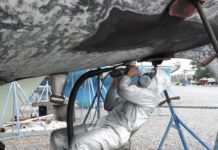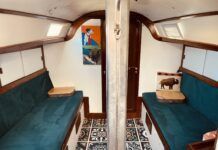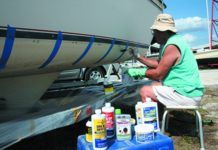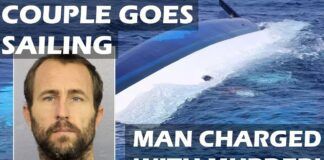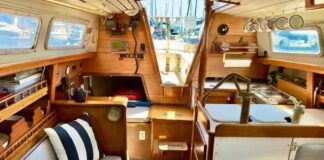Sextants
For the past 10 years I have used the Freiberger Yacht Sextant, which I find ideal on a 40-foot boat at sea, and which has given flawless performance during that time. But I was disappointed to find that your article did not even mention this excellent sextant to new navigators, and I was surprised to read your statement on page 6 that Duties from Germany have priced previously affordable units like the Frieberger Drum sextant effectively out of the American market. This is a completely misleading statement to new navigators who may not know the difference between Freibergers Yacht Sextant and their Drum Sextant. The Freiberger Yacht Sextant is retail-priced in the U.S. at $590. Thus, it is priced competitively with the highly touted Astra IIIB listed at $445 to $485 in the Celestaire 2001 catalog. Your one-sentence dismissal of Freiberger on the basis of price is all the more puzzling considering that your article included other sextants prices as high as $2,599.
In general, your article appears to draw heavily on the Celestaire and Davis points of view, and it does not appear to represent the thorough research and informed judgment that you pride yourself on.
-Tom Tursi
Maryland School of Sailing and Seamanship
———-
I own an old U.S. Navy, Bureau of Ships, ETS sextant, which now accompanies me on offshore voyages. I also own an old plastic Davis sextant, probably the first model Davis ever produced. I put epoxy in its frame for extra strength. While there is, of course, a difference between the professional ETS and the plastic Davis, I found the Davis to be absolutely accurate on a number of ship voyages between the West Coast and Australia and the South Pacific, as well as on a sailing voyage to Hawaii and back. Contrary to the presumably greater inaccuracy of the plastic marvel when compared to the far more expensive Tamaya and Plath sextants on board the ship, we noticed no such thing. I fully agree with you that practicing celestial navigation offshore will give the modern sailor a satisfaction and awareness that he will never experience with GPS. But yes, I, too, rely heavily on GPS. Too bad that GPS has enticed so many totally incompetent people to set sail for distant ports, now that the old fear of getting lost at sea is gone.
-Louk Wijsen
Alameda, CA
———-
On Calypso’s Grounding
Some years ago when I was in Tahiti on my Brown 37′ Searunner tri,I took the crew of a charter jet for a sail. On our return inside the reef north of Maeva Beach, I became distracted by the hilarious activities on deck and drove my boat hard aground on a coral head.
The music never stopped. We took in the sails.I herded everyone aft, jumped off the bow onto the coral, lifted and pushed with all my might and the boat came free. Big cheers and mai-tais all around! Boats are supposed to float. Right? And the lighter the better!
Massive keels to support bulletproof hulls that need powerful windlasses to haul tremendous anchors and chains begin to sound as though youre taking a Tiger Tank to sea. Somewhere along the line there must be a point of diminishing returns.
But of course, different boats suit different folks.
-Ted Toomay
Vista, CA
———-
Just read about Calypsos reef visit, and would like to pass on some experience, regretfully obtained over the years. In our Yankee Clipper 41, and more recently in our Columbia 43, we have found bottom more often than is desirable, especially for my wife. We have never, not once, been towed off, mud, sand or rock. Since we have a fine mast for can’ting the boat, thats what we do. If even a small runabout takes a line from the masthead, and heads off 45 degrees on the bow or stern, depending on which way we want to head for deeper water, the heeling angle achieved will reduce the draft enough to get off anything we have managed to get on. I would estimate we can reduce our draft by two feet, easily, and the boats engine will finish the ungrounding duties with ease. We have kedged off, again using a line to the masthead instead of the bow, and would have enjoyed the power available to Calypso through her mighty power windlass. Snatch blocks and the cockpit winches managed to handle the chore for us. Since the depth of water is about 60′, masthead to bottom, scope is a consideration, but it is not an insurmountable factor.
-Jim Martin
Via e-mail, S/V Rainbow
———-
Very Wrong Number
Thank God OCENS (WeatherStation 2000 HW; May 1, 2001) doesn’t build sailboats. The error message you got looked like a phone number, so I called it. I got a regional call center for Microsoft. The recorded message advised that because of technical difficulties, my question could not be answered that day. Go figure!
My wife and I sail a Catalina 25 on a lake in Kansas and love it. The wind never fails to blow in Kansas. Thanks for your fine publication.
-Bruce C. Ward
Wichita, KS
———-
Repowering Options
L. Digioia asked about replacing his 25-horse Graymarine gas inboard with an outboard (May 15, 2001). Your answer was right on track, but you stopped short. An outboard smells too! It burns fossil fuel, represents a fire and explosion hazard, and a good one will cost four grand or more. And it still needs the care and attention that his Graymarine missed.There is a very interesting alternative that might be more reasonable than a first impression would suggest: Go electric!
ELCO Marine has many years of experience powering fairly large craft with electric propulsion motors (put trolling motor out of your mind) using a large bank of big batteries. A more modern alternative can be seen at www.solomontechnologies.com.
There are trade-offs, but imagine powering out of a marina with clean hands but without noise, smoke, smell, threat of fire, hazard of carbon monoxide, or telltale oil slick!
-Sandy Daugherty
Via e-mail
———-
Just a note on the good advice offered to the reader. I have not had to repower, but why change one terrible odor (Graymarine) for another (outboard)? With much less construction damage and design one could install an electric motor. I know they are available from Electric-auto, Vetus, and others. A friend of mine put one in his Triton and is very happy with its service. The engines are reliable and with proper battery banks can offer 16 hours of service between charges. Why not go odor free…
-Karel Boersma
Via e-mail
Editor’s Note: Practical Sailor is working on a report on Solomon Technologies’ Electric Wheel right now. Look for it in an upcoming issue.
———-
…Where Credit is Due
To Raytheon Marine, Nashua, NH: I was recently given a RayMarine 100 handheld VHF radio. After about 30 seconds of normal operation, the speaker died and I could get no audio output of any kind. As the radio was a gift, I could not produce a receipt to validate the warranty. Notwithstanding, RayMarine repaired the unit and shipped it back to me in a matter of days and without charge.
-Edward Thornton, Agat, Guam
To PYI, Lynnwood, WA: Recently the non-metallic composite blades of the Max Prop feathering propeller installed on my Beneteau 321 sheared off at the roots. PYI, Inc., who had supplied the propeller, inspected it and concluded that it was an impact failure rather than a stress failure or a design flaw. However, since the composite blades were damaged beyond repair, PYI offered to replace the propeller at no charge to me. Imagine my surprise and delight when I received a top-of-the-line brand new propeller with bronze blades. Customer support of this caliber is rare.
-Meryl R. Jackson, Carriere, MS
To Lee Sails Northeast, Patchogue, NY: Last year I blew out the original jib on my 1967 Cal 25, so I ordered a new one from Lee Sails Northeast, as their sail was substantially lower-priced (including shipping) than any made locally. When I tried it out it performed beautifully, but there was one problem: When I would take it down and tie it to a lifeline (it was a hanked sail) the hanks, which had spring toggles, would climb over one another and hook together. I called Lee Sails and asked them to replace the spring hanks with piston hanks (like my old jib had). Madeline at Lee Sails said that they would replace the hanks, but that it was not cost effective to return the sail to Lee; instead, take it to a local loft, get it repaired to my satisfaction, and they would pay for it. I took it to Super Sailmakers (I was in Fort Lauderdale at the time) and they replaced the spring hanks with piston hanks. I paid the bill, picked up the jib, and sent the invoice to Lee. I shortly received a check for the full amount of the repair. When my original 34-year-old genoa blows out, I know where to get another.
-Joseph H. Kozak, Jr., Portsmouth, VA


















